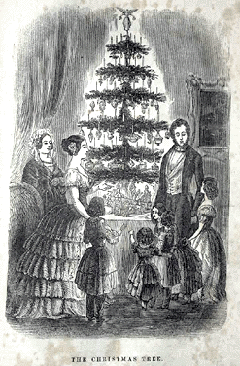No one is actually sure how the tradition of the Christmas tree began, but going back through history, a plausible picture leading to the Christmas tree we know today is painted. The use of plants in the home for religious celebrations can be traced all the way back to the ancient Egyptians and their worship of the sun god, Ra. At the summer solstice, the Egyptians brought green palm rushes into their homes to celebrate Ra’s recovery from the dark winter, and as symbols of the triumph of life over death in Egypt and the world.
Centuries later, the ancient Romans also used greenery for religious celebrations. They had a feast called the Saturnalia for the summer solstice, in honor of the god Saturn, who was also the god of agriculture. To celebrate the coming of fields full of produce, they decorated their homes for the feast with branches from evergreen trees.
Later, in northern Europe, the Celtic Druid priests often decorated their temples with evergreen tree branches as symbols of eternal life. Vikings believed their sun god, Balder, was especially fond of and protective of evergreen plants and trees.
As can be seen, there is a clear and consistent use of greenery, particularly evergreen greenery, in people’s homes throughout human history. These are just some examples we know about. There are likely quite a few others.
So, there is an established history of green plants and religious ceremonies, and the Christmas tree fits naturally into that. The question of when Christmas trees first became a “thing” is a little murkier. It is known that about 1,000 years ago, the people of northern Europe used to hang fir trees upside down from their ceilings during the Christmas season, but the reason why they did so is not clear.
During the Middle Ages, northern Europe continued with the “plants at Christmas” tradition by bringing cherry and hawthorn plants inside in pots with the hope they would flower for Christmas. The people who couldn’t afford to buy plants made pyramids out of wood and decorated them to look like trees adorned with apples, candles, and paper.

The use of the first modern Christmas tree is claimed by both the city of Tallinn in Estonia and the city of Riga in Latvia. Tallinn claims to have used a modern Christmas tree in their town square in 1441, while Riga claims to have done the same thing in 1510. Both towns say their trees were put up by local merchants and ship owners, in their town squares, where their sponsors danced around them, and then set them on fire. This is similar to the Yule Log custom. It is not known whether either of these incidents actually took place and if they did, which city was really the first one. However, the town square of Riga does have a plaque commemorating it as the location of the first Christmas tree.
There is a painting from 1521 in Germany that depicts a tree being paraded through the streets of a town with a man dressed as St. Nicholas riding a horse behind it.
In 1570, the town of Breman, Germany, recorded in their official town records that during Christmastime, a tree decorated with “apples, nuts, dates, pretzels, and paper flowers,” was displayed in a guild house in the town.
Most historians generally believe that the modern Christmas tree began in Germany in the 1500s, and some even believe the famous original Protestant reformist, Martin Luther, was the first one to use one. The belief is that he brought a fir tree into his home at Christmastime and decorated it with candles, and was the first one to decorate a tree inside their home this way. As the story goes, he was inspired by a nighttime forest scene he walked through on his way home, while composing a sermon, and wanted to recapture the scene for his family. The tree represented the forest and the candles represented the starlight in the forest at night.
What is known for certain is that for a few centuries, the modern Christmas tree as we know it existed in Germany. It wasn’t introduced to America until the mid-1800’s when German settlers brought Christmas trees to Pennsylvania that they started to become more common sights. However, Americans did not accept Christmas trees easily, looking at them as pagan symbols and not to be used with religious holidays.
Meanwhile, the Christmas tree became more popular in Europe as the German custom made its way across the continent. By the 1840s, the tradition had reached the United Kingdom, where Queen Victoria and Prince Albert were photographed with one in Windsor Castle in 1841. The royal family took up the Christmas tree tradition thereafter. Because Americans followed the royals and British high society closely during that time, using trans-Atlantic newspaper, Christmas trees slowly began to become more popular in America, thanks to Queen Victoria’s influence.
The Victorian court and British society during Victoria’s reign decorated their trees with candles, which were supposed to represent stars, as with the story of Martin Luther’s tree. Candles are still common Christmas tree decorations in other parts of Europe besides the UK to this day.

It is not surprising that Americans were so resistant to Christmas trees. With much of the country having Puritan origins, particularly in New England, Christmas was a sacred and solemn holiday, and they did not want its significance being distracted from by any kind of celebration of the holiday other than a church sermon. In fact, in 1659, Massachusetts made any observance of Christmas other than church illegal and punishable by jail and/or fines. Even putting up decorations was not allowed. Even as other Christian denominations gained footholds in America, the solemn celebration of Christmas was expected just about everywhere until Victoria and Albert made Christmas fun for the rest of the western world.
Today, Christmas trees are common, and it is hard to imagine they were not part of our culture until so recently. But, looking back through their history, it is fascinating to learn of the place such trees have had in human society going back thousands of years and how they evolved into the Christmas trees we know and love today.






